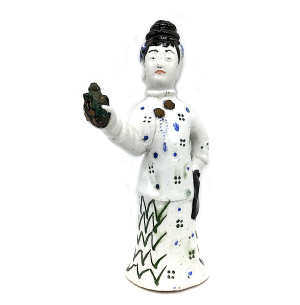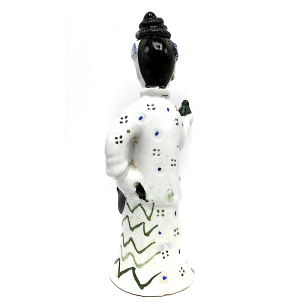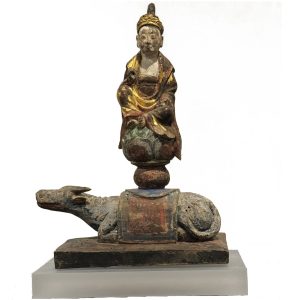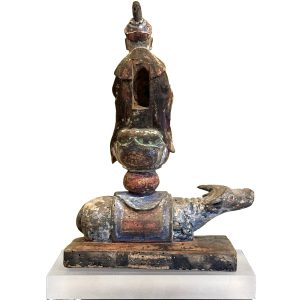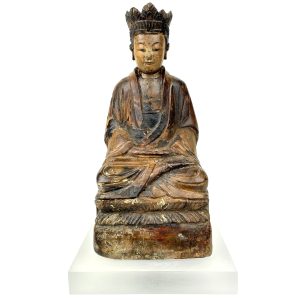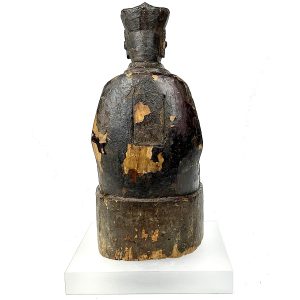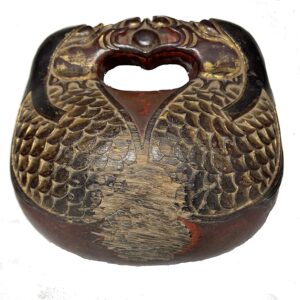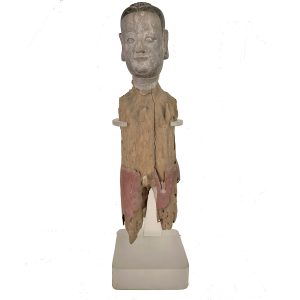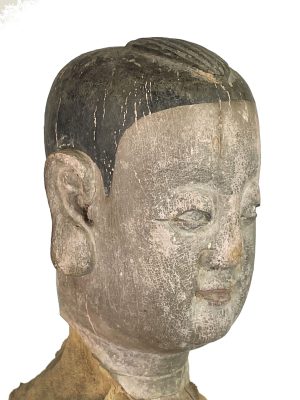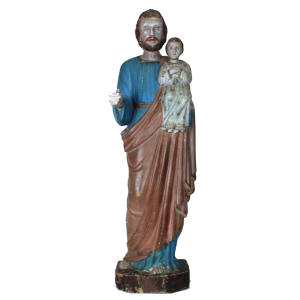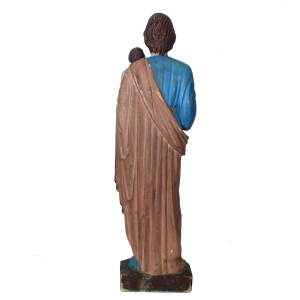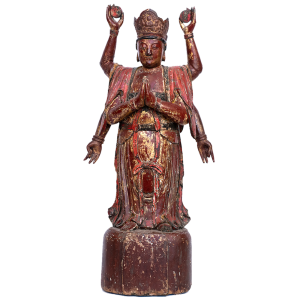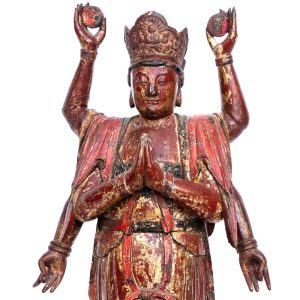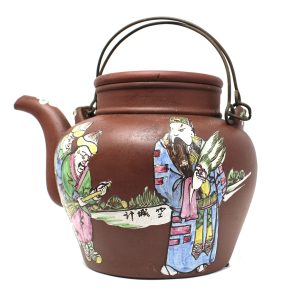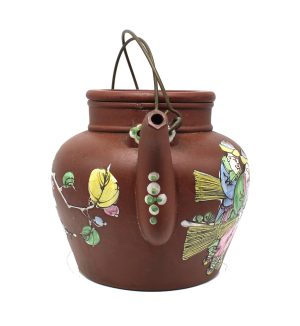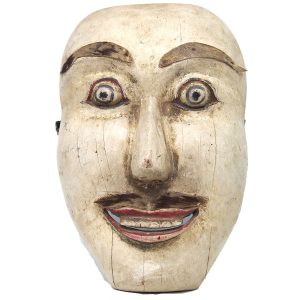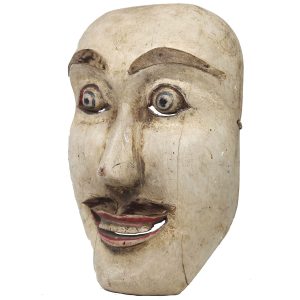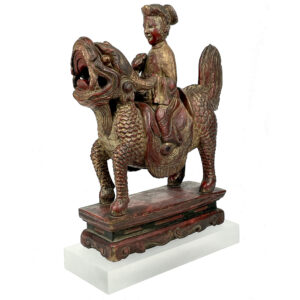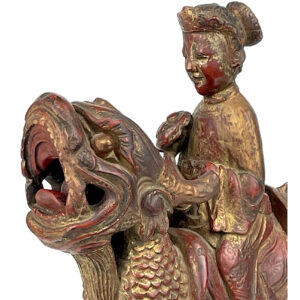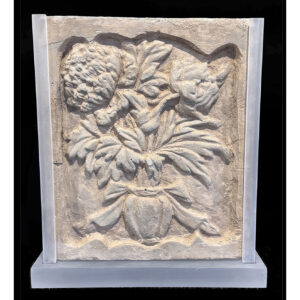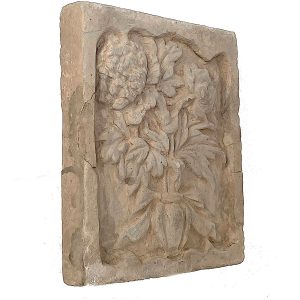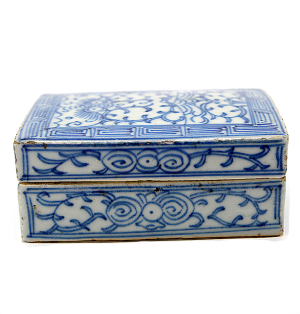Showing 241–252 of 313 results
-


$265.00
Ht: 8.5” W: 5” D: 3” | FREE SHIPPING WITHIN CONTINENTAL U.S.!
This small charming Qing or early Chinese Republic teapot is in the form of an attendant, the arm she holds up imitates the spout of a teapot, the left arm arches to touch her waist suggesting a teapot handle and the hair is atop her head with flowers is a removable lid for pouring tea inside. She typical attendant clothing, a high mandarin collared jacket draped over a flaring skirt that is the piece’s base.
-


$885.00
H: 10.25″ W: 7.5″ D: 3.75″ | FREE SHIPPING WITHIN CONTINENTAL U.S.!
This extraordinary rare and delicately rendered rural carving is a female bodhisattva possibly Guanyin seated on a lotus throne atop an ox. Beautifully highlighted in vibrant gold and adorned with intricate designs on the lotus petals and ox’s saddle coverings, this statue shows how the concept of a bodhisattva was adapted to the deification of “draft animals” (beasts of burden) who were integral to rural daily and agricultural activities in Chinese Popular Religion, Buddhism and Taoism beliefs.
-
Sale!


$695.00 Original price was: $695.00.$425.00Current price is: $425.00.
Ht: 9.5″ W: 4.5″ D: 3.75″ FREE SHIPPING in Continental U.S.!
This delicately carved home altar Guanyin is gender neutral in meditation on a lotus throne. Her humble demeanor, modest robes and absence of stylized decorative details exemplify the best of provincial Ming and Qing carvings. She is a tranquil figure with simple, soft, and beautifully rendered facial wearing a five-lobed crown symbolically representing the five Dyhani Buddhas and reflecting Vajrayana Tantric influence.
-


$875.00
This rare and beautiful cadence drum was used in a Chinese temple to help monks and chanters think about the meaning of the texts they recite. Carved fish scales and two fish heads embrace a pearl carved on the handle to symbolize unanimity and accord. The fish pair is similar to the popular pair of…
-


$650.00
H: 17” W: 5” D: 5” | FOR SHIPPING quote CONTACT US AT 213-568-3030 or email [email protected]
This rare wood carving of the Buddha as an infant is remarkable because of the way it has survived. As with many antique Chinese wood carvings, there is extensive deterioration from age/insect damage. Although there is total loss to the arms, legs and torso, it is virtually untouched from the neck up. This is a piece for lovers of wood, with the body worn to a delicately smooth but irregular surface. It is probably more striking than original piece, as its erosion shows the random miracle of chance and is highlighted on a frosted acrylic base.
-


$4,800.00
This special and important carving of Joseph with the Christ child from Kerala reflects a blend of Portuguese and European traditions with the indigenous traditions of South India. Christian missionaries built churches in Kerala from 1510 (St. Francis Church in Kochi) through the18th century and brought with them European carvings, paintings, and other large and…
-


$4,200.00
This statue reflects the Tantric Buddhism (Vajrayana or Esoteric) tradition involving mystical concepts and practices, elaborate rituals and a strong hierarchical structure that departs from mainstream Buddhism. Many Chinese Buddhist, Taoist and Tantric deities are either very difficult to identify or are confused with other divinities, as they are sometimes presented without identifying attributes or…
-
Sale!


$975.00 Original price was: $975.00.$695.00Current price is: $695.00.
H: 6” W: 8.5” D: 6.125” | FREE SHIPPING IN CONTINENTAL U.S.!
Yixing stoneware teapots are praised as the best in the world for tea infusion. This gorgeous, extremely rare antique teapot with tight-fitting lid and elegant spout is finely decorated with a brown wash and hand applied bright painted enamel designs designs of a scene from the Peking opera Romance of Three Kingdoms. The floral images are a wish for a long and healthy life, perfect metaphors for those sharing a fresh pot of tea with those they love. Kiln seals are impressed in the body, bottom and lid.
-


$395.00
Balinese carvings and masks are ethnic folk art and a blend of Hinduism and its initial animism. Most masks made in Bali are from pulai wood that rarely cracks and is easier to carve. As it is not native to Lombok, carvers there use a variety of woods some of which were dense with others light….
-
Sale!


$895.00 Original price was: $895.00.$625.00Current price is: $625.00.
H: 9.5” W: 2.25” D: 6.5” | FREE SHIPPING within Continental U.S.!
This remarkable figurine is Guanyin on her mythical mount, the Hǒu, guardian master of the universe and model for righteousness and morality who symbolizes bringing forth peace and prosperity.The round orb in its mouth representing a pearl can be rubbed for good luck. It is one of our most unique and favorite Buddhist statues, mounted on a frosted Acrylic stand.
-


$995.00
H: 11” W: 9.5” D: 1.65” | FREE SHIPPING
This earthenware brick tile bordered with a deep scalloped frame depicts a vase with a bouquet of propitious flowers: a chrysanthemum and a peony wrapped with an elegant ribbon. Tiles like this were made to decorate the large numbers of buildings created during the prosperous Song dynasty and to adorn tombs. This elegant brick is in good condition for its age with expected chips and cracks, some restoration of background and a re-glued frame break on each side. It has earth adherents from its burial in a tomb.
-


$115.00
SOLD
This finely hand-painted rectangular porcelain cobalt blue and white box with underglaze designs was used to store ink cakes as part of an assortment of prized items on a Chinese scholar’s desk. The cover is painted with bindweed designs, wave-like curved lines usually indicating water, and a fanciful bat’s face inside a continuous geometric meander or fret pattern. The box sides are covered with bindweed, spirals, and circles, and although circles and round shapes are usually associated with or represent heaven, these seem strictly decorative. There are traces of red, brown, and black ink inside and on the edges of the unglazed portions and rough and stained areas on the unglazed portions of the box and wear consistent with and demonstrating its age and use.
End of content
End of content

